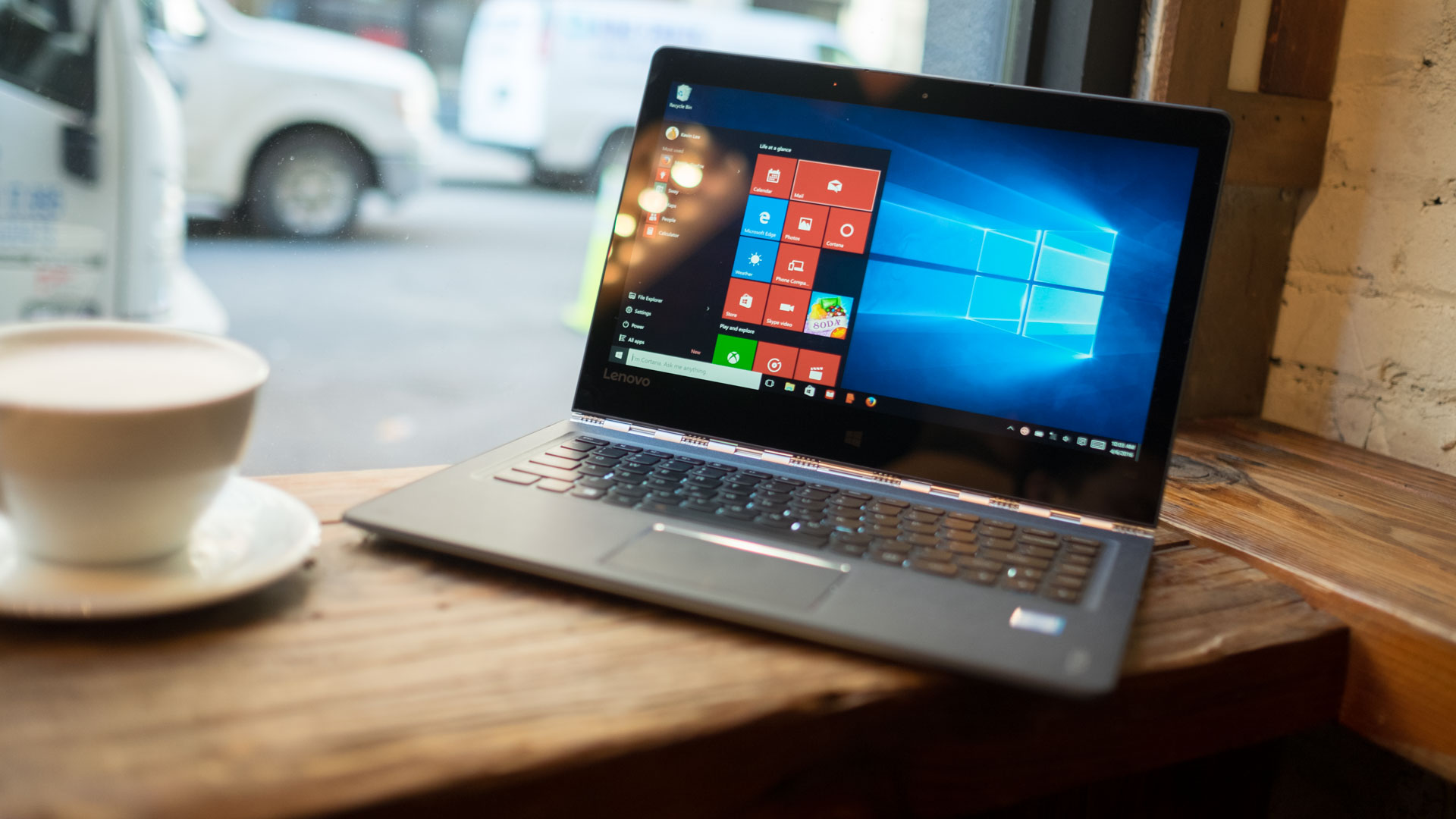Why you can trust TechRadar
By using Intel's Core i series processors, Lenovo fixed the main complaint with the Yoga 3 Pro. The Core i processor on this year's Yoga 900 is far more powerful than the Core M processor on last year's model, and to help improve battery life, Lenovo said that it has increased the battery by 50% on this generation.
Here's the Lenovo Yoga 900 configuration sent to techradar for review:
Specifications
- Processor: 2.5GHz Intel Core i7-6500U (dual-core, 4MB cache, up to 3.1GHz with Turbo Boost)
- Graphics: Intel HD Graphics 520
- Display: 13.3-inch QHD+ 3,200 x 1,800 IPS display, 10-point multitouch, 300 nits brightness
- Storage: 512GB SSD
- Memory: 16GB LP-DDR3 RAM
- Camera: 720p front-facing
- Ports: 2 x USB Type A 3.0, 1 x USB Type C 3.0 with video out, 1 x DC input with USB 2.0 functionality, 4-in-1 card reader, audio combo jack.
- Weight: 2.84 pounds
- Size: 12.75 x 8.86 x 0.59 inches
While the top, bottom and hinge are silver on our review unit, the sides of the Yoga 900 are black. There is one USB port on each side of the laptop. On the left side, you'll also find a multi-card reader and a USB-C port. Lenovo representatives confirmed that you cannot charge the Yoga 900 through this port.
Essentially, the new USB-C port is used to output video to a monitor or for connecting devices, like Google's Nexus 6P smartphone, to your laptop for data transfer. The Yoga 900 lacks a dedicated video output port, like HDMI or DisplayPort.
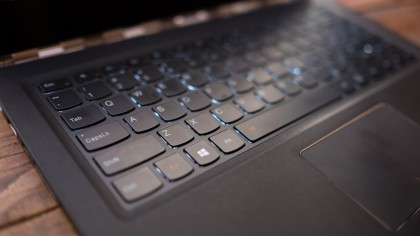
You'll also find Lenovo's proprietary power port on the left side. The power cable has a flat tip, and you'll notice that it looks similar to a traditional USB port. Lenovo made some enhancements to this port so that when you're not using the power cable to charge your Yoga, you can also use this port as a USB 2.0 port, giving your laptop three total USB ports.
Similarly, you can use remove the power cable from the power brick, connect a USB cable and use the power brick to charge a phone or tablet. This innovation allows business travelers to leave behind their smartphone charger if they want to alternate between charging the Yoga and their mobile device.
On the right side, you'll find the combo audio jack, raised power button and an auto-rotate lock button, which is useful in tablet mode.
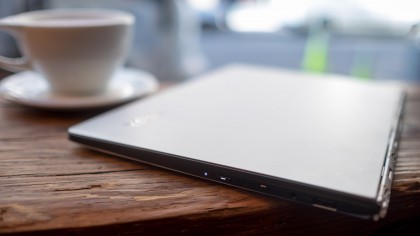
Pricing for the Yoga 900 at this configuration is $1,499 (£997, AU$2,131). For comparison, at this price point, you'll be able to get the base Surface Book with an Intel Core i5 processor, 8GB RAM, 128GB solid state storage and no discrete graphics. You'd be getting more for your money with the Yoga.
At the base configuration, the Yoga 900 will come with an Intel Core i7 processor, 8GB RAM and a 256GB solid state drive. Unlike the Surface Book, none of the Yoga 900 configurations come with discrete graphics, so the line's performance is similar to the Surface Pro 4, as both rely on Intel's integrated HD Graphics.
At CES 2016, Lenovo also announced a business variant of this hybrid called the Yoga 900 Business Edition. The enterprise variant is designed around the BYOD movement and adds support for a TPM module.
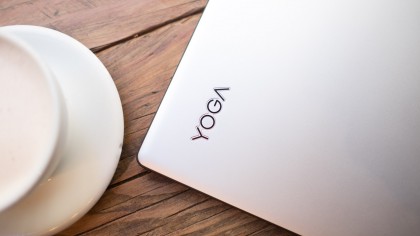
Benchmarks
- 3DMark: Fire Strike: 844; Sky Diver: 3,342; Cloud Gate: 5,469
- Cinebench CPU: 291 points; Graphics: 35 fps
- GeekBench: 3,031 (single-core); 5,591 (multi-core)
- PCMark 8: 2,261 points
- PCMark 8 Battery Life: 5 hours and 6 minutes
- techradar movie battery life: 7 hours and 21 minutes
Surprisingly, the benchmarks for Intel's Core i7 Skylake processor is only marginally better than the Core M-5Y70 CPU on last year's Yoga 3 Pro. The Yoga 900 scored 2,261 points on PCMark 8's test, compared to the 2,165 points scored by the Yoga 3 Pro.
Where the new Yoga 900 shines is in the graphics department. The more powerful HD graphics on Skylake generated scores of 844 on 3DMark's Fire Strike test, 3,342 on Sky Diver and 5,469 on Cloud Gate. The Yoga 3 Pro only scored 329, 1,406 and 2,738, respectively, or half as well as this year's model.
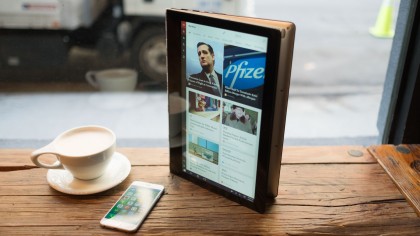
Compared to Microsoft's Surface Pro 4, which is one of the few convertible notebooks that's released with Intel's sixth generation processor, the Yoga 900 delivered similar results. Our Intel Core i5-equipped Surface Pro 4 generated 2,406 points on PCMark 8's CPU test. It scored 856, 3,673 and 5,873 points on Fire Strike, Sky Diver and Cloud Gate graphics tests.
Similarly, our Surface Book with an Intel Core i5 processor score 2,336 points on the PCMark 8 benchmark. The Surface Book benefited from its discrete GPU in the graphics department, generating scores of 1,868, 6,089 and 7,285 on Fire Strike, Sky Diver and Cloud Gate tests, respectively. These graphics scores are roughly double the performance of the integrated Intel HD Graphics 520.
Compared to the Spectre x360, which runs last generation's Intel Broadwell processors, the PCMark and 3DMark results are fairly similar without any big differences in performance. The Spectre generated 2,424 points on PCMark, 621 points on Fire Strike, 2,297 on Sky Diver and 4,722 on Cloud Gate tests.
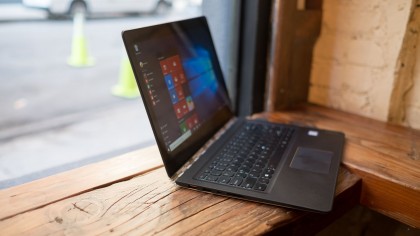
Even though Lenovo increased battery capacity on the Yoga 900 by 50%, battery life remains the same, with the 900 scoring 5 hours and 6 minutes on PCMark 8's intensive battery test, while the Yoga 3 Pro generated 5 hours and 15 minutes. In my casual observation based on internet browsing, word processing and text-based messaging, the Yoga 900 fared over seven hours with the screen brightness set to 50%. This number is still short of the eight hours that Lenovo promised. We'll update this review after more battery tests are performed.
Looking at these numbers, it appears that there is little difference in processing performance from this year's Skylake Core i7 and Core i5 processors, but more importantly, CPU performance is similar across Skylake, Broadwell and Broadwell Core M chips. Where there is a big difference is in the graphics department between Skylake's integrated graphics and last year's Core M's integrated graphics.

Performance
Benchmarks only tell part of the story, and real-world usage generally frames the narrative around how a laptop works. The Yoga 900 performs faster than any device with a first generation Intel Core M processor, thanks to its high-end Core i7 Skylake CPU.
Apps launched quickly, and I was able to perform basic video and photo editing without any lags or issues. Similarly, multitasking was no challenge for the Yoga 900. I had several Chrome browser windows open, each with multiple tabs, Microsoft Word and Excel in the background, three different chat and messaging clients as well as my standard Windows 10 Mail and Calendar apps.
One of the first things that I did when I began using the Yoga 900 is remove the bundled McAfee anti-virus software. I didn't notice any performance improvements after the uninstallation, but I was relieved of the annoying popups.
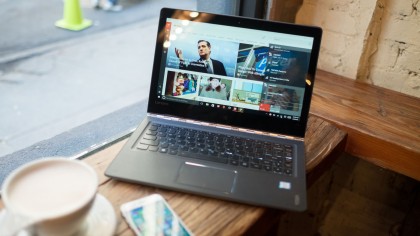
Yet, despite its performance, I am not quite sure Lenovo made the most out of Skylake. When Skylake launched in early fall, Intel said that the integrated Intel HD Graphics chip could drive up to three simultaneous 4K displays at 60 frames per second, yet the single USB-C port means that the Yoga 900 is only able to drive two displays: the laptop screen and a single external display.
Lenovo doesn't offer any docking station to expand the Yoga 900's capabilities. On the other hand, Microsoft's Surface Dock brings more power to the Surface Pro 4, allowing that device to drive two external displays in addition to the tablet's own screen, meeting Intel's three-display specifications.
When it comes to displays, it appears that Windows 10 hasn't been fully optimized to take advantage of Skylake. I noticed constant popups alerting me that the Intel display driver had crashed, especially while performing graphic-intensive tasks. Additionally, I also experienced an issue with screen flickering.
Fortunately, it appears that screen flickering only occurs, at least to my eyes, when the display is cold. After the screen warms up after about 10 minutes of use, the flickering stops, but it's still a worrying issue for a top shelf convertible Ultrabook system from one of Microsoft's largest OEM partners. Hopefully, the screen can be tuned with a future software update.
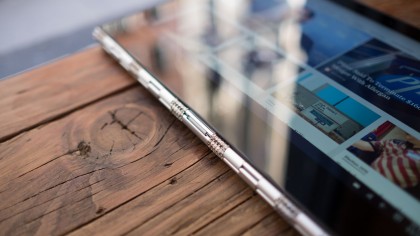
If you're viewing the Yoga 900's screen from an angle under bright light, you'll also notice small dots arranged in a grid pattern on the display. These dots likely help with touchscreen performance, but can be a bit distracting.
Multimedia performance is stellar, aided by the stereo bottom-firing JBL speakers that are tuned by Dolby. Music sounded rich and audio sounded loud enough to fill a room, and there is no distortion even at the highest volume. If you listen to more bass-heavy music, you'll likely want to connect external speakers, but I had no issues with videos, movies and tracks that are heavy on vocals and acoustics for such a slim device.
Even with the screen folded back and covering the speakers in tablet mode, there was no issue with sound output. I only wished that Lenovo added physical volume buttons for use in tablet mode. This way, you won't need to fiddle with Windows 10's small menus.
